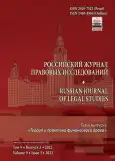Experience in the Application of Forensic Examination Techniques in IAEA Regional Nuclear Forensic Exercises
- Authors: Nitrean A.I.1, Stebelkov V.A.2, Zhizhin K.D.2
-
Affiliations:
- Forensic and Legal Expertise Center
- Laboratory for Microparticle Analysis
- Issue: Vol 9, No 3 (2022)
- Pages: 85-92
- Section: Review
- URL: https://journals.rcsi.science/2410-7522/article/view/109496
- DOI: https://doi.org/10.17816/RJLS109496
- ID: 109496
Cite item
Abstract
It was shown that the five-day format of the exercise was sufficient for the participants to practically master the procedure and characteristic features of all the main stages of the investigation of a crime with NRM, from the examination of the crime scene to development of an expert opinion. The procedure for choosing the parameters of the RDD imitators used in the exercises has been worked out. The informativeness of the main methods for performing forensic examinations — SEM-EDX, SIMS, ISP MS and fingerprinting — in the conditions of the short exercises was demonstrated. In environmental samples as well as on the surrounding items in the “workshop of terrorists”, identical particles of NRM simulators were identified — particles of lead oxide with a characteristic morphology — and tungsten microparticles with a modified isotopic composition were also studied. The possibility of the participants mastering the methods of dactyloscopy was also shown. Some mistakes made by the exercises participants were noted, which necessitate additional training and new exercises.
Full Text
##article.viewOnOriginalSite##About the authors
Alina I. Nitrean
Forensic and Legal Expertise Center
Email: nitreanalina@gmail.com
Moldova, Republic of, Chisinau
Vladimir A. Stebelkov
Laboratory for Microparticle Analysis
Email: v.stebelkov@lma.su
ORCID iD: 0000-0002-4360-1258
PhD
Russian Federation, MoscowKirill D. Zhizhin
Laboratory for Microparticle Analysis
Author for correspondence.
Email: c.zhizhin@lma.su
Russian Federation, Moscow
References
- Ujba VV, Kvacheva YuE, Stebel’kov VA. i dr. Polonievaya versiya smerti Yasira Arafata: Rezul’taty rossijskih issledovanij. Medicinskaya radiologiya i radiacionnaya bezopasnost’. 2015;60(3):41–49. (In Russ.).
- Schwantes JM, Marsden O. Fourth Collaborative Materials Exercise After Action Report. PNNL-24410. Pacific Northwest National Laboratory. Richland, WA, 2015. 135 p.
- Schwantes J, Marsden O, Taylor F. Fifth Collaborative Materials Exercise After Action Report, ITWG. 2018. 103 p.
- Schwantes J, Marsden O. Sixth Collaborative Materials Exercise After Action Report, Draft, ITWG. 2021. 153 p.
- Nitrean A. Particularitătile examinării urmelor papilare pe obiecte contaminate cu radionuclizi (Osobennosti issledovaniya sledov ruk na ob”ektah, zagryaznennyh radionuklidami). Aktual’nye nauchnye issledovaniya v sovremennom mire. ISCIENCE.IN.UA. 2022;3(83):5255.
Supplementary files












